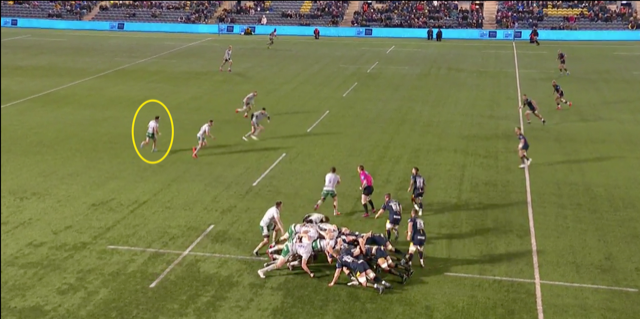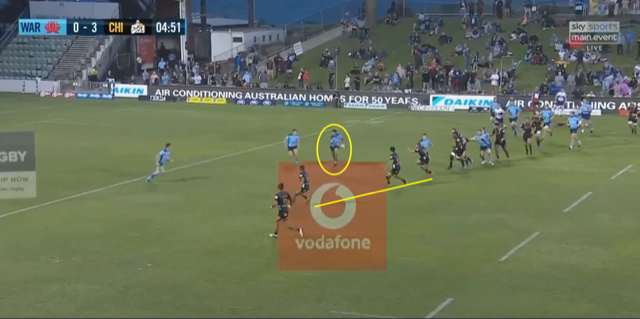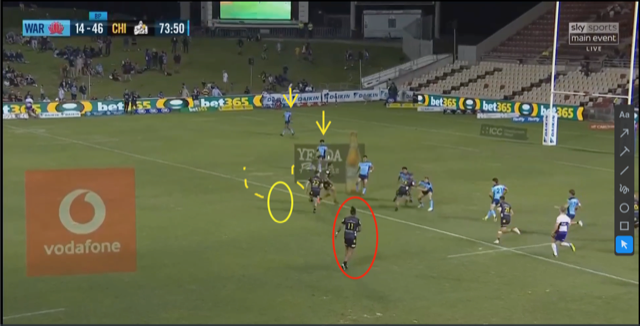Bending the Line
Some time ago I worked with Backs Coach Andre Bell who would often speak of ‘bending the line’ with his attack. I was always intrigued by this but to be honest never had a full understanding of its use. With defence now often dominating the game, bending the line is being seen by more teams around the world and it has grown from being a simple ‘back door’ pass to one of many variations and options.
Teams in the northern hemisphere are showing greater variation than us in the south who still look to carry hard and play off the back of that. Teams like Bristol and Northampton show a real willingness to test the defence at every opportunity.
Teams that really rush up hard on defence cannot afford a slight disconnect in their line integrity and creative attacking sides are looking at doing just that by having ‘front door’ and ‘back door’ options but more importantly very active blindside wingers. Running lines and timing are key to success in these plays, all players must be a genuine threat and players from depth look more effective when hitting onto the ball late. Second touch rugby allows the attack to get greater numbers around the ball which help create these options. Coaches are really testing some of the old ways of thinking, particularly straight running. At one stage any lateral runner was mainly used to get the ball to a more direct runner. However now we are seeing a lateral runner often pass to another on a similar line. Don’t get me wrong there is still need to straighten the attack to hold the defence but isn’t scoring tries what the game is all about!

Front Door Back Door option
The most commonly seen adaption of bending the line can be best illustrated in this clip. The forwards are primarily the front door option while the backs sit deeper to provide the back door. However engaging the defence is still a key requirement and while the backdoor creates space for the edge the defending number 8 needed to be engaged. He does a great job of keeping live here.

Working in the Winger
In this clip we can really see the high workmate of the blindside winger and the effect it has on the defence. He forces the far winger to join the line and when the 10 gets the first back door pass the fullback is forced up too and line speed slows. The looping 10 throws a pass that puts the trailing winger in space. Effectively the defence must defend three waves of attack.

Speed as a Weapon
This clip shows a similar attack to the previous however the mindset of the attack is to hit up and build a phase. This slows down the ball carrier and has him searching for his runner. Speed is a weapon and if the ball carrier and the support winger really hit their straps and attacked the 12-13 then they may have found themselves in space with players spare on the outside.

Strike to Score
A great opportunity to ‘strike to score’ here and bend the line to find space in the outside channels. The Chiefs were probably looking to hit up and come back here so their blind winger was disconnected . However they missed a great opportunity to score if the blind winger stayed involved and ran a line similar to that of the previous clips.
How to develop Bend the Line Attack
The Rugby Site has several videos for coaches to watch and implement a ‘Bend the Line’ Attack including:
Andre Bell – https://www.therugbysite.com/coaching-videos/position-specific/kobelco-steelers-series?part=2#part-1
Graham Henry’s Stanford University clinic – https://www.therugbysite.com/coaching-videos/attack/2017-usa-coaching-clinic-attack-strategies?part=2#part-1
Dan Carter – Crusader Attack at the end of his Kobelco Steelers Interview https://www.therugbysite.com/coaching-videos/interviews/dan-carter-interview.
My Running lines video – https://www.therugbysite.com/coaching-videos/coaches-corner/iranz?part=14#part-13
Summary
So the battle between Attack Coaches and Defence Coaches will continue to introduce new innovations to the game and I look forward to seeing how these pan out. The northern game is often played to large crowds while the southern game has dwindling numbers. Is this a reflection of the innovations we are seeing? Who knows, but as individual skills increase we could see some very close battles in the coming years.
Check out more posts from Dave












.jpg)

.jpg)







